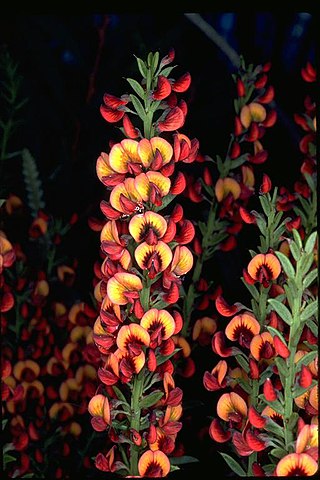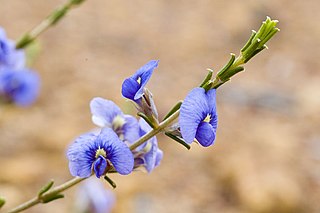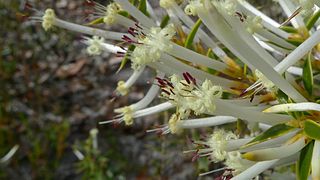
Lechenaultia biloba, commonly known as blue leschenaultia, is a species of flowering plant in the family Goodeniaceae and is endemic to the south-west of Western Australia. It is a glabrous herb or subshrub with spreading branches, almost no leaves, and yellow, tube-shaped flowers.

Conospermum acerosum, commonly known as needle-leaved smokebush, is a species of flowering plant in family Proteaceae and is endemic to the south west of Western Australia. It is spindly, erect or straggly shrub with needle-shaped or thread-like leaves, panicles of white or pink flowers and reddish brown nuts.

Conospermum glumaceum, commonly known as hooded smokebush, is a species of flowering plant in the family Proteaceae and is endemic to the south-west of Western Australia. It is an erect shrub with more or less clustered, linear leaves, and panicles of dense, head-like spikes of tube-shaped, cream-coloured flowers and white to golden nuts.

Grevillea eriostachya, also known as flame grevillea, orange grevillea, or honey grevillea, is a species of flowering plant in the family Proteaceae and is endemic to western parts of Australia. It is a shrub with a leafy base, mostly linear leaves and conical groups of bright yellow flowers on long canes above the foliage.

Calytrix aurea is a species of flowering plant in the myrtle family Myrtaceae and is endemic to the south-west of Western Australia. It is a shrub with elliptic, lance-shaped or linear leaves and clusters of yellow flowers with 25 to 55 yellow stamens in several rows.

Beaufortia purpurea, commonly known as purple beaufortia, is a species of flowering plant in the myrtle family, Myrtaceae and is endemic to the southwest of Western Australia. It is an erect or spreading shrub with linear to egg-shaped leaves and purplish-red flowers in dense heads on the ends of branches which continue to grow after flowering.

Verticordia densiflora, commonly known as compacted featherflower, is a flowering plant in the myrtle family, Myrtaceae and is endemic to the south-west of Western Australia. It is a shrub with small leaves, usually small pink and white flowers and which is widespread in the south-west of the state. It is a variable species and in his 1991 paper, Alex George formally described five varieties.

Verticordia densiflora var. densiflora is a flowering plant in the myrtle family, Myrtaceae and is endemic to the south-west of Western Australia. It is a shrub with small leaves and pink or, occasionally white flowers. It is one of 5 varieties of the species Verticordia densiflora.
Verticordia densiflora var. rosteostella is a flowering plant in the myrtle family, Myrtaceae and is endemic to the south-west of Western Australia. It is a shrub with small leaves and small groups of star-like, yellowish and pink flowers. It is one of 5 varieties of the species Verticordia densiflora.
Verticordia densiflora var. stelluligera is a flowering plant in the myrtle family, Myrtaceae and is endemic to the south-west of Western Australia. It is an openly branched shrub with small leaves and small clusters of yellowish or pink and cream flowers. It is one of 5 varieties of the species Verticordia densiflora.

Darwinia pinifolia is a species of flowering plant in the family Myrtaceae and is endemic to the southwest of Western Australia. It is a low, spreading to prostrate shrub with linear leaves and dense heads of erect, red to purple flowers.

Calytrix angulata, commonly known as yellow starflower, is a species of flowering plant in the myrtle family Myrtaceae and is endemic to the south-west of Western Australia. It is a shrub with linear to egg-shaped leaves and clusters of yellowish-cream coloured flowers with 30 to 40 yellow stamens in several rows.

Daviesia longifolia is a species of flowering plant in the family Fabaceae and is endemic to the south-west of Western Australia. It is an erect, many-stemmed shrub with scattered, erect, cylindrical phyllodes and yellow and red flowers.

Lechenaultia juncea, commonly known as scarlet leschenaultia, is a species of flowering plant in the family Goodeniaceae and is endemic to the south-west of Western Australia. It is an open, ascending shrub with narrow, crowded, rather fleshy leaves, and scarlet to orange-red flowers.

Lasiopetalum glutinosum is a species of flowering plant in the family Malvaceae and is endemic to the south-west of Western Australia. It is a spreading, multi-stemmed shrub with densely hairy young stems, egg-shaped leaves often with three lobes and bright pink or dark red flowers.

Daviesia polyphylla is a species of flowering plant in the family Fabaceae and is endemic to the south-west of Western Australia. It is a bushy, spreading, glabrous shrub with narrowly egg-shaped or elliptic, sharply-pointed phyllodes and yellow and dark red flowers.

Mirbelia floribunda, commonly known as purple mirbelia, is a species of flowering plant in the family Fabaceae and is endemic to the south-west of Western Australia. It is an erect, slender or straggling, much-branched shrub with narrowly linear leaves and bluish-purple flowers.

Styphelia insularis is a species of flowering plant in the heath family Ericaceae and is endemic to the south-west of Western Australia. It is a rigid, scrubby shrub with many branches, linear or oblong leaves and tube-shaped, white flowers.

Conostephium preissii is a species of flowering plant in the family Ericaceae and is endemic to the southwest of Western Australia. It is an erect shrub with many stems, egg-shaped to oblong leaves and white and purplish to reddish-pink flowers.

Styphelia tenuiflora, commonly known as common pinheath, is a species of flowering plant in the heath family Ericaceae and is endemic to the south-west of Western Australia. It is an erect shrub with broadly egg-shaped to lance-shaped leaves and whitish-cream, tube-shaped flowers with hairy lobes.



















